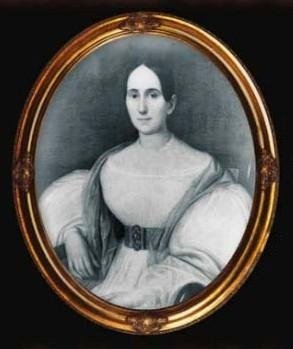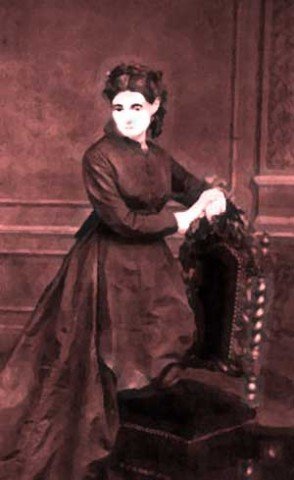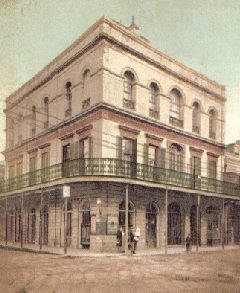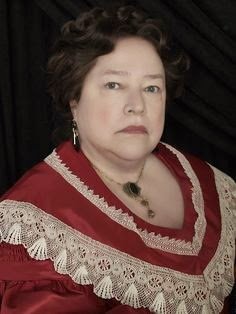Delphine LaLaurie; The Socialite Slave-killer

Slavery is one of the most abhorrent human practices. In order to enslave another human being, you must be prepared to deny them their individuality. This basic attitude of ignoring the reality of another person’s experience lies at the heart of most criminal behaviour – theft, murder, fraud and worse all stem from regarding your own pleasure as real, and other people’s suffering as illusory. So it is that slaves are often treated with almost inhuman cruelty, precisely because their masters need to think of them as less than human. Naturally, this is not a healthy mental attitude to take. As society becomes more civilised, so the mental habits needed for slavery become harder to maintain, and so the practise eventually falls into disuse. In the USA, the (almost unique) racial component of slavery helped to extend the practise far past the level of societal development where it had usually been thrown by the wayside. By the middle of the 18th century it had nearly torn the country in two – and eventually it would. Nowhere was this division more apparent than in Louisiana. Here nearly half of the population was enslaved – yet it was also one of the states with the largest number of free black citizens. It was within this divided state that the actions of Delphine LaLaurie would become infamous.
Delphine was born as Marie Delphine Macarty on the 19th March 1787. [1] She was the product of the old world – Bartholomew McCarthy, her great grandfather, was an Irishman in service to the Duke of Albemarle when the Stuart armies lost the English civil war. He accompanied the Duke and King Charles of England as they fled to France. The Stuarts would return to England, but Bartholomew married a French woman and stayed in France, in military service to the King of France. His sons Louis Barthelemy and Jean Jacques (who spelt their name as de Macarty) also went into the military. Reputedly Louis served as a bodyguard to the King before he moved to the French colony of Louisiana with his brother. Here they prospered, both marrying into powerful local families. The Macarty family became one of the great Louisiana families themselves, as the two brothers’ children became rich landowners and powerful plantation holders. In 1764, the colony was ceded to the Spanish, but the Macarty family remained at the top of the social heap. [2] One of Louis’ sons, also named Louis Barthelemy, married Marie Jeanne L’erable, a wealthy widow, sometime between 1770 and 1783. In 1784 they had a son, named Jean Jacques, and in 1787 they had a girl. They named her Marie Delphine.

Delphine was a noted beauty, and it surprised nobody in 1800 when she married Don Ramon de Lopez y Angullo, a high-ranking officer in the local Spanish garrison. That year, under the Emperor Napoleon Bonaparte, France took back the territory from Spain in a treaty. Don Ramon stayed in New Orleans with his wife, and became the Spanish consul general – a role he retained through the purchase of the territory by America in 1803. He died in Havana in 1804, though the circumstances of his death are somewhat mysterious. Some stories have it that he was on his way to Spain to visit the court, others that he was returning from such a visit. Some have it that he was being recalled for punishment, others to be honoured. Whether Delphine visited the court is also in dispute, as some of those who say he was travelling to the court say that she went ahead. Regardless of how it happpened, however, on March 26th 1804 Delphine became a widow.
Four years later, in 1808, she remarried. Her new husband was Jean Baptiste Blanque, a banker in New Orleans. Blanque was clearly not as lily-white as his name might suggest – he was heavily, if discreetly, involved in the slave trade. One odd curiosity is that surviving records make it appear that he sold far more slaves than he ever purchased – indicating, perhaps, that the source of these slaves was not legal. In 1812 war broke out between the USA and Great Britain. A key location near New Orleans was the independent settlement of Barataria, a lawless port ran by the Lafitte brothers and maintained through a mix of smuggling and piracy. The port existed in an uneasy symbiosis with New Orleans, as it allowed the citizens access to smuggled goods from the Caribbean that they had become used to before the US trade embargoes and taxes cut them off. Of course, the authorities hated the place, and managed to imprison Pierre Lafitte. However at this point the war front moved to Louisiana, and the lack of defences in New Orleans became a serious risk. Jean Lafitte courted both sides of the struggle, and Blanque (described as “a friend”, but in reality probably a broker for his trade in New Orleans) was his main contact in the US camp. Pierre “escaped”, and shortly thereafter the Baratarians agreed to aid in the defense of New Orleans. In the ensuing battle, the Baratarians distinguished themselves, and following the US victory they were all granted full pardons, with many choosing to stay on in the US Navy. Barataria effectively ceased to exist, as all those who remained were absorbed into New Orleans. [3]

Blanque died in 1816, leaving Delphine a widow once more. She had one teenage daughter from her marriage with Don Ramon (a girl named Marie Francoise, but known more commonly as “Borquita”, who had been born after his death), and four children from her second marriage. She also had a considerable fortune and was considered one of the great beauties of New Orleans, however, and so in 1825 she married Doctor Leonard Louis Nicolas LaLaurie, who was sixteen years younger than her, and very much the subservient partner in the marriage. In 1831 she purchased a site on Royal Street, and by the next year she had built a three-storey mansion. It was around this time that the first stories of her cruelty to slaves began to emerge. How much of this is exaggerated in hindsight is hard to say. Delphine’s name appears on two petitions of manumission, so she was prepared to free slaves. On the other hand, the “singularly haggard and wretched” condition of her slaves meant that a lawyer was sent to her mansion in 1834 to officially remind her of the laws forbidding their mistreatment. [4] He found no direct evidence of cruelty, but stories continued to spread. One told of a twelve-year-old girl named Leah fleeing in terror from Delphine after hitting a snag in her hair and throwing herself out of a third storey window in a panic. The body, so they said, was secretly buried in the grounds of the mansion. Another story told of nine of her slaves being confiscated due to their poor condition and her mistreatment of them, and of Delphine secretly buying them back through agents. Whatever secrets the LaLaurie Mansion held, however, were not destined to remain secret for long. On April 10, 1834, fate took a hand.

When a fire broke out at the LaLaurie mansion, bystanders rushed to help. It was a hectic scene, and the accounts tend to be jumbled, but a definite picture emerges from the accounts. As they helped transport the LaLaurie’s possessions out of danger, they began to ask questions. Where were the household slaves? they asked. Delphine refused to answer. They discovered the cook, chained to the stove by her ankle and terrified (she would later admit to starting the fire as a suicide attempt.) She babbled something about the attic, and so some of them went to investigate. They found the attic locked, and asked for the keys, but Delphine refused them “in a gross and insulting manner”. So they broke the door down. The New Orleans Bee [5] described the scene they found as “the most appalling spectacle”. The Bee said there were “seven slaves more or less horribly mutilated”, hung by their necks from the walls. [6] The discovery sparked a riot, possibly the first in New Orleans’ history, and the mansion was wrecked. The sheriff and the judge eventually managed to restore order, but not until the mob and the fire between them had gutted the LaLaurie house.
Delphine had fled once she realised the attic was going to be opened. The seven slaves were taken to the jail for treatment (no hospital being available), and the article in the Bee the next day says that several thousand people came to see them (probably an exaggeration). Two of them would later die of their wounds, while police investigating the mansion found several bodies illegally buried on the premises – including that of a child (possibly the girl who fell from the window). The mood was definitely ugly. Before the mob could turn on her, Delphine fled. She took a coach to the waterfront and a boat that eventually took her to Paris. (What happened to her husband is unclear, as he is not mentioned in any of the stories.) There she eventually died, in either 1847 or 1842. [7] She was buried in Paris, though her family eventually had her exhumed and returned to Louisiana. In 1941 newspapers published that workers in the St. Louis Cemetery found the copper plate from her tomb.

Of course, there are those who still maintain that Delphine was simply the victim of a hostile press and false stories designed to whip up a mob against an innocent woman (well, as innocent as any slave owner can be, anyway.) Regardless of the truth of it, however, “Mad Madame LaLaurie” became one of the most prominent figures of New Orleans folklore. In the process her story grew in the telling – the torture her slaves had suffered became even more intense and she herself became even more demonic. This reached its culmination in 2013 when the third series of American Horror Story had Delphine (played by Kathy Bates) as an immortal sadist who used body parts from her slaves in beauty potions. The LaLaurie mansion was renovated, and became a girl’s school [8], before going through a variety of different uses, such as a furniture shop or an apartment block. Ghost stories, of course, surrounded it. In 2007 it was purchased by the actor Nicholas Cage, though he may since have sold it on. Two hundred years later, and Delphine remains a figure of fascination. The horror of the acts she perpetrated continues to fascinate us, but we mustn’t forget that it all started with her being taught that some people weren’t human. They were only slaves.
[1] Some sources give her birth year as 1775. However the baptismal records at St Louis Cathedral in New Orleans have it as 1787.
[2] An attempt by some of the colonists to resist the new Spanish rulers was quashed in 1768 by the wonderfully named Alejandro O’Reilly.
[3] The Lafitte brothers went on to serve as Spanish spies in the Mexican war of independence. Pierre settled in New Orleans as a blacksmith and reported on the US interest in the area, while Jean founded a new colony on Galveston Island. Pierre’s fate is unknown, but Jean went on to join the Columbian Navy and eventually died in battle with the Spanish.
[4] Laws “protecting” slaves went back to the Romans. After the Servile Wars, they realised that there was a limit to how much mistreatment people would take before any potential penalty for rebellion became meaningless.
[5] The most successful newspaper in the city at the time, it actually published the majority of its content in French, with a supplemental in English.
[6] Some accounts have it that there were slaves with their mouths stitched shut, others with their limbs sewn together. Later accounts would exaggerate this even further.
[7] George Washington Cable, in his excitable Strange True Stories of Louisiana tells a story that she died in a boar-hunting accident. Quite what a 60 year old former society matron was doing out boar hunting is unclear.
[8] And the site of a shameful episode in the 1870s which Cable recounts, where a baying mob of white supremacists besieged it and forced all those they suspected of “racial impurity” to leave.
